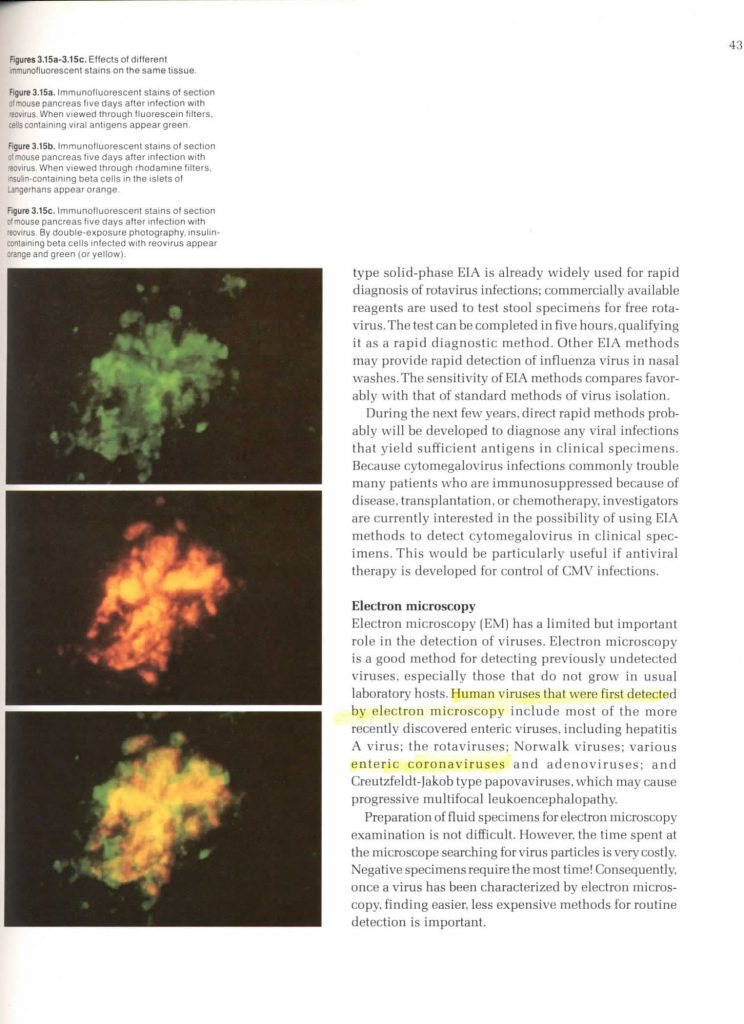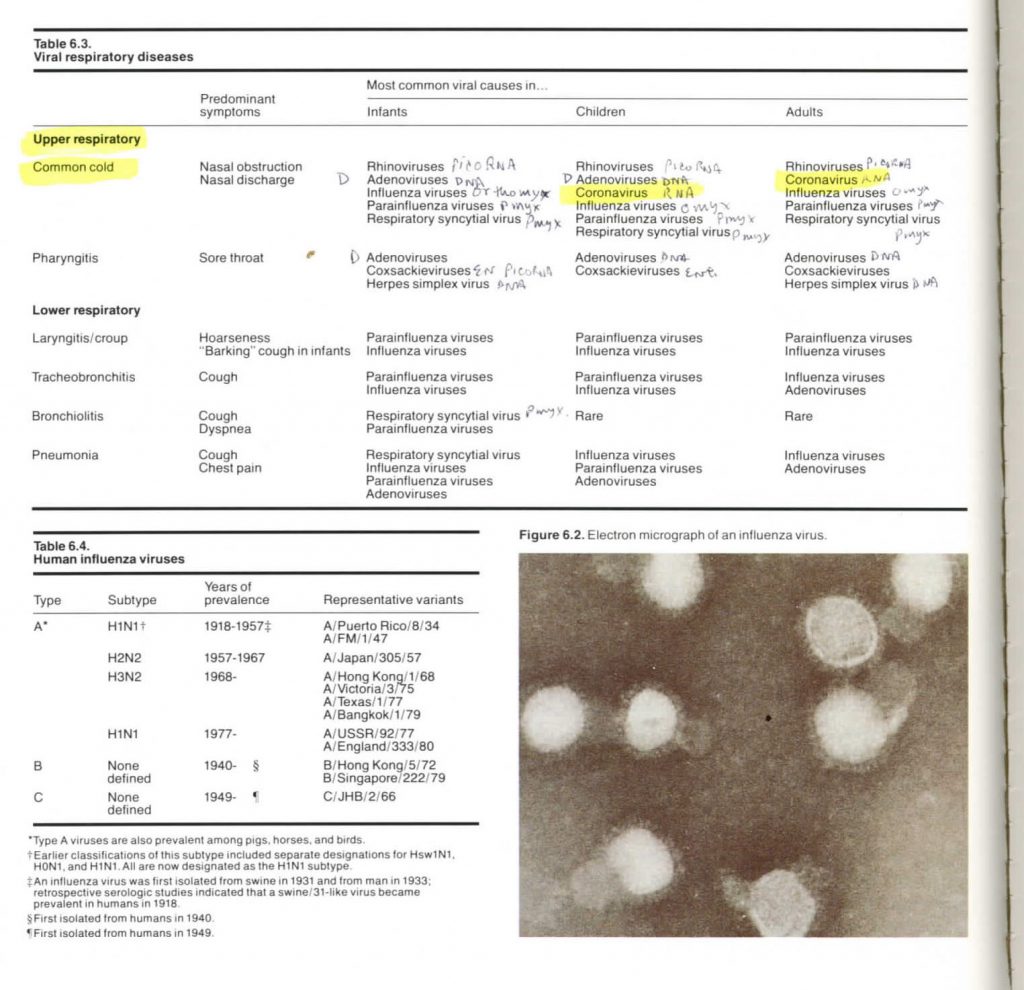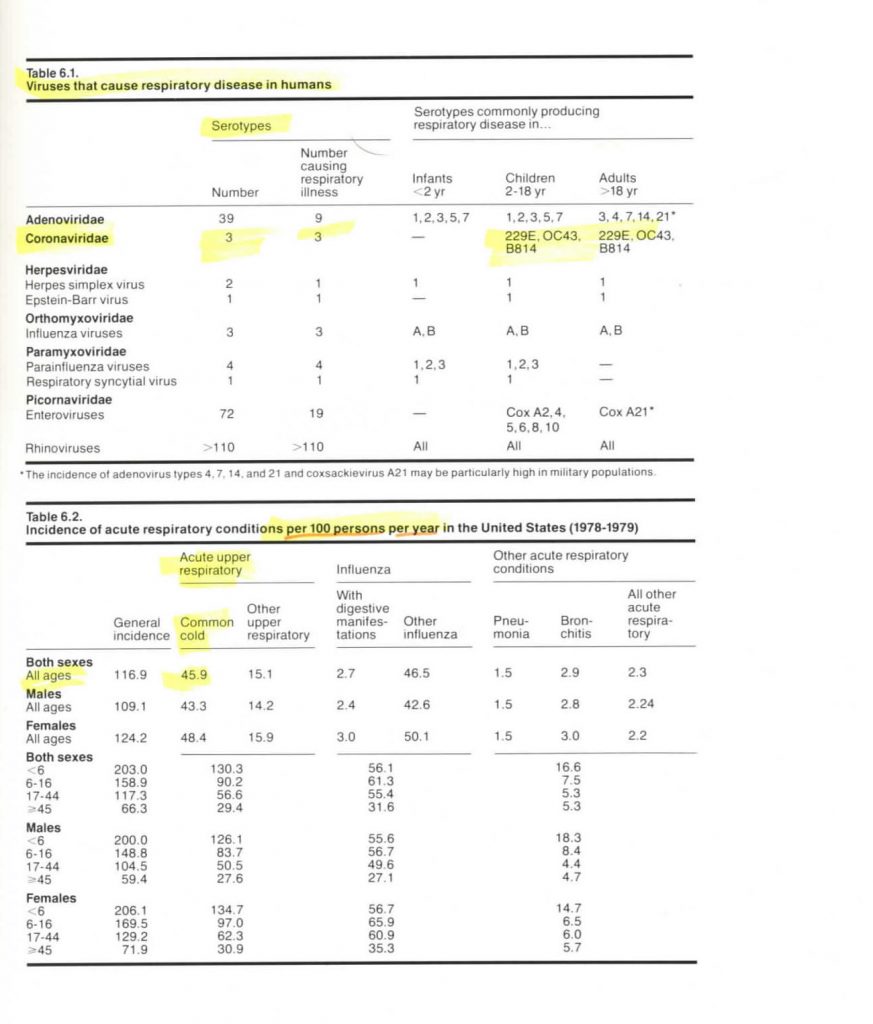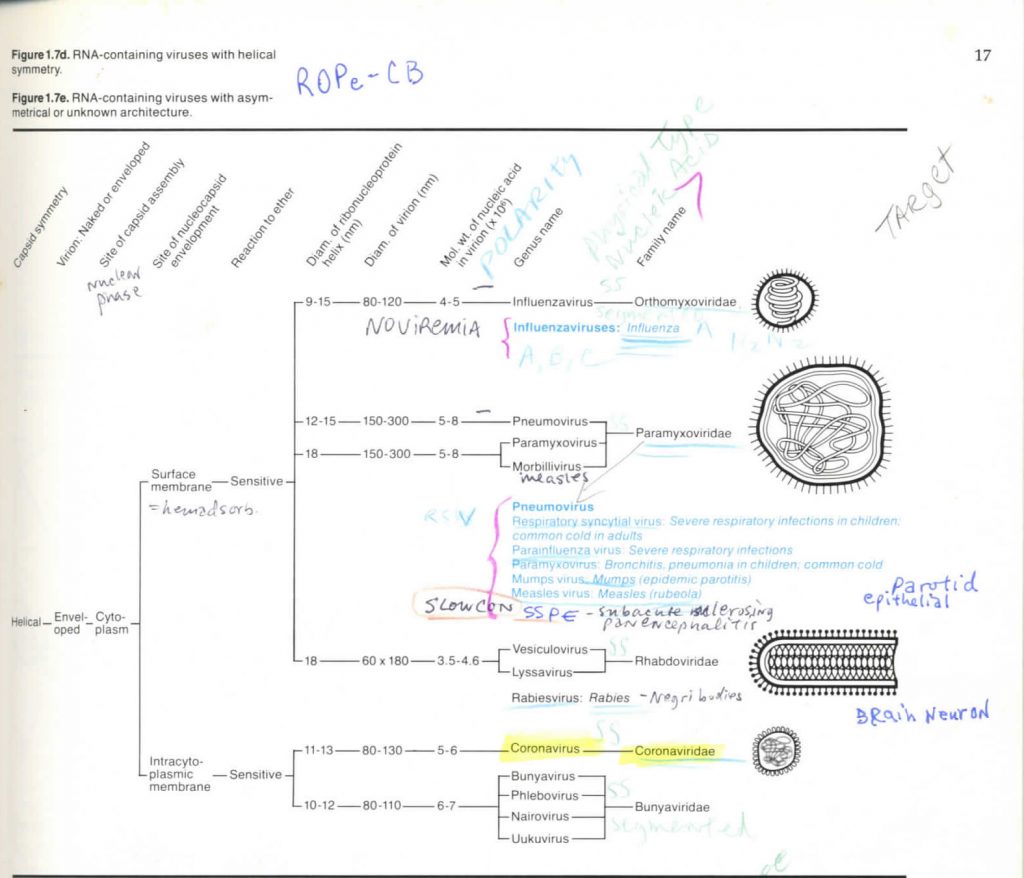CoronaVirus is ‘common cold’ for 15% of Adults.
CoronaVirus is the ‘common cold’ for 15% of Adults.

Coronaviruses. Members of the coronavirus group cause a broad spectrum of disease in a variety of animals including humans. The biology and epidemiology of these viruses are incompletely characterized; at least three serotypes have been identified, and they may cause infection in persons of all ages. Most prominent in winter, they cause about 15% of common colds in adults: however, they do not appear to be significant causes of lower respiratory disease. No specific treatment or preventive measure is available. Source Virology.
Just what is the ‘common cold’? Just what is the ‘flu’? The ‘common cold’ is part of Acute Upper respiratory maladies, divided among about seven serotypes. The ‘flu’ is also a part of Acute Upper Respiratory maladies and includes several influenza viruses. The symptoms are the same in all – fever, cough, sore throat, mucus, head ache, pains, red eyes, thirst, and more. See the table 6.1 for their names.
There is a difference between pathogenic (bad or make you sick) virus and bad bacteria. A virus works inside a cell, and is about one thousandth smaller than a bacteria. As recently as the 1980s, about 1500 bad viruses had been identified and segregated, with treatments to prevent attack for about 300 of those viruses. The first virus to be identified was rabies, isolated by Louis Pasteur in France well over a century ago. Pasteur could not even see it. Nevertheless, he discovered a prevention, and rabies stopped being the death sentence it had previously been. Visual confirmation of what viruses look like, had to await the electron microscope.
Pathogen comes from the Greek word pathos for suffering or passion plus genes for producer. Pathogen is applied to microorganisms including virus, bacteria, fungus, and protozoan.

Electron microscopy (EM) is a good method for detecting previously undetected viruses, especially those that do not grow in usual laboratory hosts. Human viruses that were first detected by electron microscopy include most of the more recently discovered enteric viruses including – various enteric coronaviruses, etc.
Bacteria, although tiny, can be seen thru a glass microscope. Bad bacteria cause diseases named to include strep, staph, pneumonia, brucellosis, syphilis, and more. These are not viruses.
Viruses need an electron microscope for visual identification. Bad viruses have names, different looks, means of replicating (growing), and are associated or grouped in families.
Here is the bottom line as extracted from a Virology treatise.
Corona virus is responsible for 15% of the common cold. CoronaVirus was identified by Electron Microscope and CoronaVirus has been followed since the 1970s. COVID – 19 stands for Coronavirus Disease 2019.
There are 3 serotype of CoronaVirus.

Table 6.3 Viral respiratory diseases. Upper respiratory Common Cold. Predominant symptoms Nasal Obstruction, Nasal Discharge, Most common viral causes in Children Coronavirus, Adults CoronaVirus. Other comparative viral causes for Infants, children, and adults are Rhinoviruses, Adenoviruses, Influenza viruses, Parainfluenze viruses.
Bottom 6.4 Human influenza viruses. Type A. Subtype H1N1,
What do these tables tell? So, anecdotally, I have had cold symptoms every winter of my adult life. My colds were never tested, so as to isolate or identify which virus I had at the time. The symptoms were fever, sore throat, green mucus, aches and pains. The same symptoms for hundreds of maladies. For each cold, my chance of having the CoronaVirus was 1 in 7. The chance for having one of each of 3 serotypes of CoronaVirus is 1 in 21. So after 65 years, and 65 or more colds, my odds of having one of each of the 3 serotypes of Coronavirus is 3 to 1. Statistically, I have had 3 colds with each of the serotypes. Recovery from a cold, or virus, strengthens the immune response in the body, so later attacks or infections are prevented, or the effects are reduced, and shortened.
Should I get a flu shot? Yes.
The CDC web site, relates that there are 162 million doses of influenza vaccine shots made every year 2019-2020. In 2008, 27 million doses were unused, about 1 in 5, and eventually expired. The military can order soldiers to take the flu shot, so can the church before it allows missionaries to go out, but the government leaves motivation for most everyone else, with the manufacturers of influenza vaccine. So well over half of 320 million Americans, pass on the flu vaccine. The flu shots are cumulative, adding fresh virus treatments every year, and they do not overlap.

Top Table 6.1 Viruses that cause respiratory disease in humans, Coronaviridae has 3 Serotypes, all 3 number causing respiratory illness. Serotypes commonly producing respiratory disease I Infants (not recorded), Children age 2-18 year and and Adults over 18 years 229E, OC43, B814.
Bottom Table 6.2 Incidence of respiratory conditions per 100 persons per year in the United States (1978-1979) ‘Common Cold’ Acute Upper Respiratory Both Sexes All ages 45.9, compared to Influenza, Pneumonia, Bronchitis, specified. Note that General Incidence of respiratory conditions both sexes all ages is 116.9, meaning every person, all ages, will get sick 1.1 times, and among children under 6 years of age are 200 and more, or children will be sick two times every year. If some child is not sick at all, another child will have 4 ‘conditions’, to average out to 2.
In 65 years, my annual cold was never tested to identify whether it was corona virus, or one of another half dozen other virus families. The current testing for corona should Identify about 1 in 7 as corona virus. Note that about 45% of American adults every year have the common cold, and of those 1 in 7 have the CoronaVirus. The U.S. has about 209 million adults of 18 years or older as of 2020. Statistically, 31 million adults will have CoronaVirus this year, or one in ten Americans.
Lastly, viruses are alive, and come from life. Viruses do not spontaneously generate. The CoronaVirus has been around for millennia, even if it has only been isolated in the 20th century. It is not new life, although it may be new to the media.
Who should be tested for CoronaVirus? The health care professional can do the evaluation. But for many decades, patients with ‘common cold’ were not tested to identify the specific respiratory disease, to wit – whether it was Coronavirus, Rhinovirus, influenza, Adenovirus, and respiratory syncytial virus. By the time patients had ‘common cold’ symptoms, it was too late for the virus to be prevented for that patient. What can yet be prevented, in the middle of a ‘common cold,’ are bacterial infections. Bad bacteria looking for a weak or compromised host, and attempting a jump in and attach the host. This is where anti-biotics are effective, against bacterial infection. The earliest anti-biotics were sulpha drugs and penicillin, and have been expanded over the past century.
‘Virology’ is the source of these Coronavirus quotes.

Source Virology, p. 17. Family Name Coronaviridae, Genus Name Coronavirus, Molecular Weight of Nucleic acid in Virio 5.6(x 106 ), Diameter of virion 80-130 (nanometer), Diameter of ribonucleoprotein helix 11-13 (nanometer),Reaction to ether – Sensitive, Site of nucleocapsid Envelopment –intracyto-plasmic membrane, Site of Capsid assembly –cytoplasm, Virion enveloped (not naked), Capsid symmetry Helical. This table compares Coronavirus with others such as rabies, Pneumovirus, Influenzaviruses. Figure 1.7d RNA – containing viruses with helical symmetry.
Disclaimer: The author of each article published on this web site owns his or her own words. The opinions, beliefs and viewpoints expressed by the various authors and forum participants on this site do not necessarily reflect the opinions, beliefs and viewpoints of Utah Standard News or official policies of the USN and may actually reflect positions that USN actively opposes. No claim in public domain or fair use. © John Choate. UTopiAH are trade marks of copyright owner. Utopia was written about AD 1515 by Sir Thomas More.
Utah Standard News depends on the support of readers like you.
Good Journalism requires time, expertise, passion and money. We know you appreciate the coverage here. Please help us to continue as an alternative news website by becoming a subscriber or making a donation. To learn more about our subscription options or make a donation, click here.
To Advertise on UtahStandardNews.com, please contact us at: ed@utahstandardnews.com.
Comments - 2 Responses to “CoronaVirus is ‘common cold’ for 15% of Adults.”
Pings:
Leave a Reply
You must be logged in to post a comment.


Comments:
What other serotypes of coronavirus have been identified in the past 37 years? What is the name of “the church” that requires flu shot before a mission? Where is the discussion of the importance of handwashing in this?
Handwashing is covered in this column, previously posted.
https://www.utahstandardnews.com/corona-virus-update-cant-find-hand-sanitizer-no-problem-use-hydrogen-peroxide-or-isopropyl-alcohol/
The Church of Jesus Christ of Latter-day Saints is known, as of 2016, to require vaccines, such as Hepatitis, before sending out Missionaries.
The NIH URL https://www.ncbi.nlm.nih.gov/books/NBK7782/ quoted Medical Microbiology from 1996, Chapter 60 on Coronaviruses, the following, Coronaviruses (and toroviruses) are classified together on the basis of the crown or halo-like appearance of the envelope glycoproteins, and on characteristic features of chemistry and replication. Most human coronaviruses fall into one of two serotypes: OC43-like and 229E-like. – Hence 2 sterotypes.
https://www.uptodate.com/contents/coronaviruses – Update says ”There are five non-SARS coronavirus serotypes that have been associated with disease in humans: HCoV-229E, HCoV-NL63, HCoV-OC43, HCoV-HKU1, and a novel coronavirus (MERS-CoV) that emerged in 2012.” Hence 5 serotypes. ”Both HCoV-229E and HCoV-OC43 were discovered in the 1960s and were shown in volunteer experiments to produce common colds in adults [4,21-23]. Studies in the 1970s and 1980s linked them to as much as one-third of upper respiratory tract infections during winter outbreaks, 5 to 10 percent of overall colds in adults, and some proportion of lower respiratory illness in children [24-26].” ”Little further information developed after this until the emergence of SARS in 2002 and the development of molecular diagnostic methods. Then HCoV-NL63 and HCoV-HKU1 were quickly discovered and found to have worldwide distribution [27-30]. The polymerase chain reaction may be used for the diagnosis of each of the four human coronaviruses, and this technique has allowed substantial investigation into their epidemiology and pathogenicity. (See ‘Diagnosis’ below.)”
”In a study describing 138 patients with COVID-19 pneumonia in Wuhan, the most common clinical features at the onset of illness were [39]:
●Fever in 99 percent
●Fatigue in 70 percent
●Dry cough in 59 percent
●Anorexia in 40 percent
●Myalgias in 35 percent
●Dyspnea in 31 percent
●Sputum production in 27 percent”
Other, less common symptoms have included headache, sore throat, and rhinorrhea. In addition to respiratory symptoms, gastrointestinal symptoms (eg, nausea and diarrhea) have also been reported in some patients, but these are relatively uncommon [37,39].”